Types, Functions, Food Sources, Symptoms of deficiency - Fat Soluble Vitamins | 11th Nutrition and Dietetics : Chapter 11 : Vitamins, Minerals and Water
Chapter: 11th Nutrition and Dietetics : Chapter 11 : Vitamins, Minerals and Water
Fat Soluble Vitamins
Fat Soluble Vitamins
Fat – soluble vitamins are soluble in fats and fat solvents. They are insoluble in water. So these vitamins are utilized only if there is enough fat in the body.
1. Vitamin A
Vitamin A was discovered in 1909 and its chemical name is retinol. The vitamin A compounds include retinol, retinal and retinoic acid. It has a specific function in the retina of the eye. Vitamin A occurs only in foods of animal origin. Vitamin A activity is possessed by carotenoids found in plants. Hence carotenoids are called provitamin A.
Functions
· It provides the required stimulation for vision in the retina and is essential for maintaining normal vision.
· It helps in maintaining healthy skin and epithelial tissues.
· It is important for proper growth of bones.
· It helps in normal foetus development.
· It protects the mucous membrane of the digestive, respiratory and urinary tracts against infection.
Food Sources of Vitamin A
Vitamin A is present as retinol in animal sources such as egg yolk, fish (halibut, shark, cod), liver and cod liver oils. In plants, it is found in the form of carotene which gets converted to vitamin A in the body. Carrot, beetroot, turnip, papaya, mango, pumpkin, tomatoes, green leafy vegetables, drumsticks, whole milk, butter, ghee etc., are very good sources of carotene.
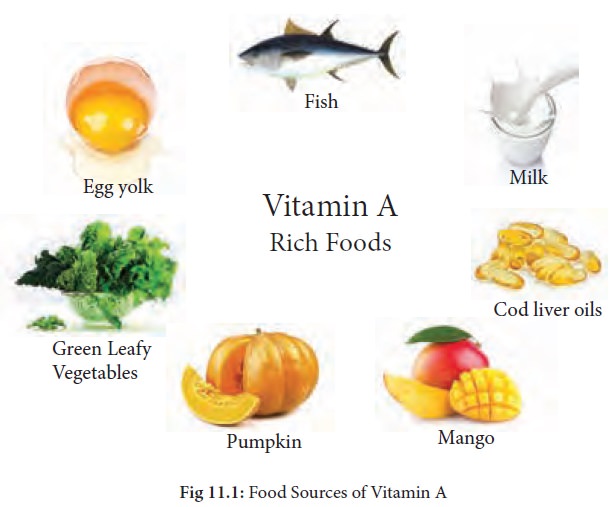
Symptoms of Vitamin A deficiency
1. Night blindness: This is also called as Nyctalopia. Initially there is itching, burning and inflammation of eyelids and the person gradually loses vision to see in the dim light.
2. Keratomalacia: This occurs due to poor intake or poor absorption of vitamin A. When conjunctival xerosis is not treated it may develop into a condition known as keratomalacia. Cornea becomes dull.
3. Xeropthalmia: This occurs in which the eyes become thickened, wrinkled and extremely dry followed by progressive cloudiness. This is due to keratinisation of the epithelial cells over the cornea. This condition is extremely common among all age groups in India and other developing
4. Bitot’s spot: Silver grey foamy deposits on the delicate membranes covering the whites of the eyes. Softening of the corneas may lead to corneal infection, perforation and degenerative tissue changes, which may result in blindness.
5. Skin becomes rough, dry and scaly. This condition is known as toad’s skin.
2. Vitamin D
Vitamin D is otherwise known as ‘sunshine vitamin’ as it can be synthesized from sunlight by our body. Hence, vitamin D requirements of Indians are considered to be met entirely by exposure to sunlight. In the absence of exposure to sunlight a daily
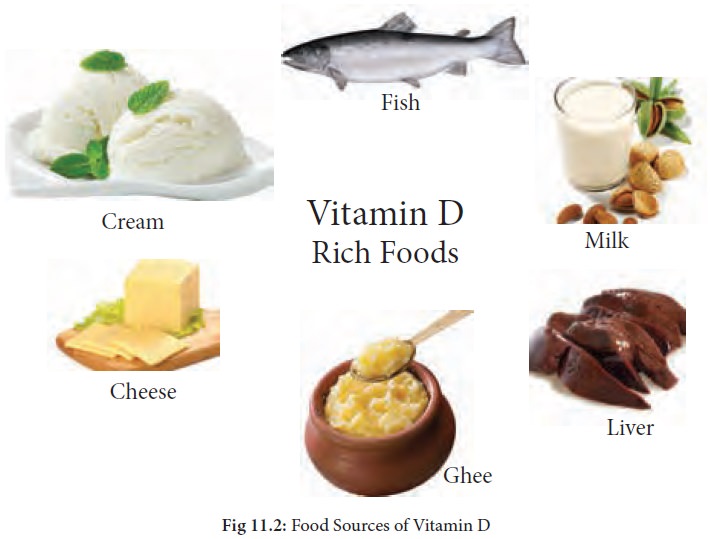
Vitamin D is produced under the skin after exposure to ultraviolet rays. Vitamin D is now considered as a pro hormone rather than a vitamin and is required for Calcium absorption and bone formation.
Functions
· It helps in the formation of bones and teeth.
· It also improves the calcification of bones.
· It helps to increase the absorption of calcium and phosphorus.
· It helps in increase of citrate content in bones and blood.
Food Sources of Vitamin D:
Sunlight: Exposure of skin to sunlight brings about synthesis of vitamin D from 7 dehydrocholesterol.
Food products: Cod liver oil, liver, salmon and herring fish, fortified milk, egg yolk, butter, cheese, ghee, cream, fortified milk, etc., are the best sources of Vitamin D.
Symptoms of Vitamin D deficiency:
Symptoms in children Rickets:
When children’s bodies don’t get enough vitamin D, they cannot absorb enough calcium and phosphorus to mineralize and harden the bones and teeth. If calcium and phosphorus are not deposited enough to
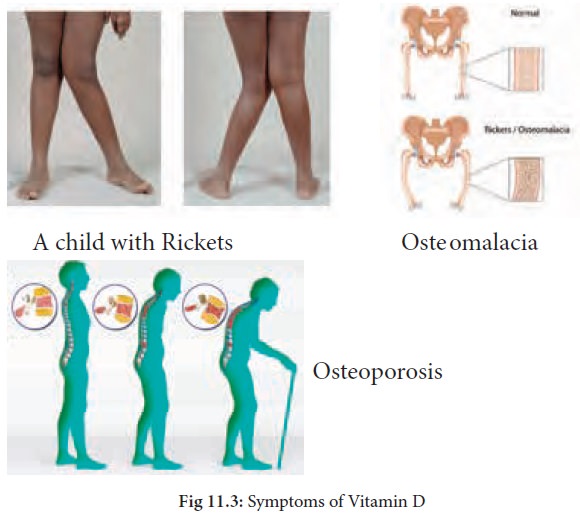
Their bones become too weak to support their weight and their legs bow under the pressure and may exhibit the following symptoms:
· Bow legs (legs bow outwards).
· Knock-knock knees (legs bow inwards with knees touching each other).
· Enlarged joints (The ends of long bones enlarge), Pigeon’s Chest (ribs become hollow and bulge out).
· Their teeth will become soft and irregular shaped.
· Head becomes abnormally large and square shaped with bulging sides.
Symptoms in Adults:
Osteomalacia:
· Adults get osteomalacia. In this disease, the bones become soft, fragile and easily bendable and are more prone to multiple fractures.
· Cramps are common.
· Spinal cord, thorax, limbs and pelvis may be deformed and back may be hunched. Person may suffer from lower back pain.
Symptoms in Oldage
Osteoporosis: It is a calcium related health problem and occurs frequently in old people.
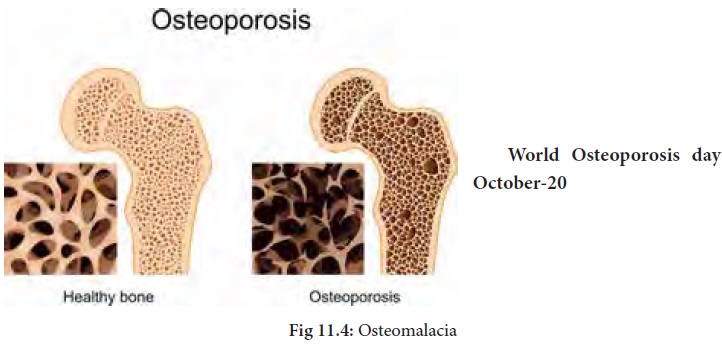
This disease is characterized by having light porous and spongy bones that break very easily. Severe bone pain is reported which is relieved by immobilization. Fractures occur due to brittle bones which heal off normally.
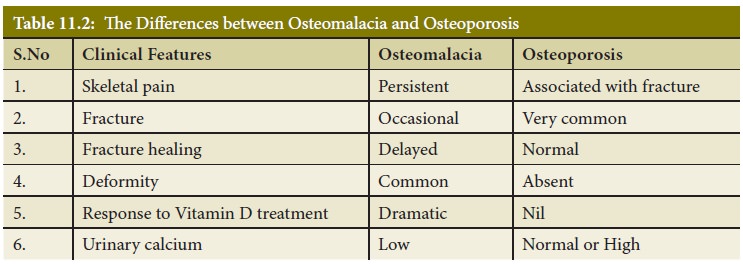
3. Vitamin E
Vitamin E protects cell membranes and other fat-soluble parts of the body. They are called as tocopherol. This word is derived from ‘tocos’ meaning child birth, and ‘phenos’ meaning to bear and ‘ol’ means alcohol. The vitamin is stored in all the tissues and the tissue stores can provide protection against the deficiency for long periods.
Functions
· Vitamin E is an important antioxidant
· Promotes normal growth and development
· Promotes normal red blood cell formation
· Acts as anti blood clotting agent
· helps in absorption of vitamin A and vitamin C.
· Vitamin E dilates the capillaries and enables the blood to flow freely into blood deficient muscle tissue, thus strengthening both the tissues and the nerves supplying them.
· reduces the risk of heart diseases
Food Sources of Vitamin E
The principle source of vitamin E in diet is vegetable oils - Corn, and peanut oil. Nuts and seeds - Almonds, hazelnuts, sunflower seeds, saffiower, soya bean oils, walnuts, margarine, meat and fish, whole grains, wheat germ, spinach, lettuce, dark green leafy vegetables, black berries, apple, pears, legumes, eggs and milk are good sources of vitamin E. Human milk has more vitamin E than cow’s milk and is sufficient for infants.
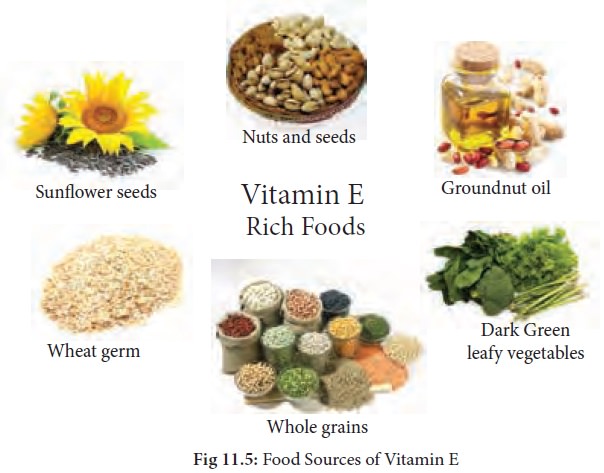
Symptoms of Vitamin E deficiency
· Anaemia in premature infants.
· Increased risk of oxidative damage to body tissues.
· Vitamin E deficiency may lead to heart and lung disease and brain stroke.
· Frequent blood clots may occur which in turn play a role in the production of varicose veins.
4. Vitamin K
Vitamin K is called coagulation vitamin. It is essential for the production of a type of protein called prothrombin and other factors involved in the blood- clotting mechanism. Prothrombin levels in the blood determine the rate at which the blood will clot. For blood to clot, fibrinogen a soluble protein must be converted into fibrin. Thrombin catalyses the proteolysis of fibrinogen to yield fibrin.
Functions
· Helps in clotting of blood.
· Participates in bone formation and remodeling(synthesisofosteocalcin).
· It isnecessary for theformation obone matrix and mineral deposition.
· Vitamin K is essential for the prevention of internal bleeding and haemorrhages.
· It is important for the normal functioning of the liver.
· It is involved in energy producing activities of the tissues and nervous system.
Food Sources of Vitamin K
The concentration of vitamin K in foods is highest in dark green leafy vegetables, especially spinach. It is also found in soyabean, yoghurt, wheat, oats, milk, meat,
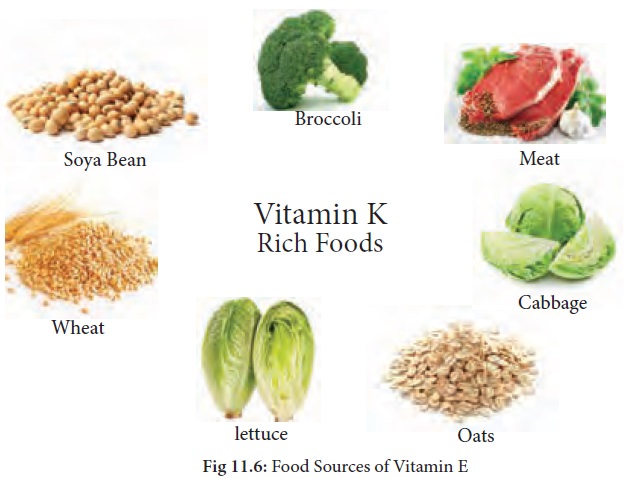
Symptoms of Vitamin K deficiency
· Leads to increased tendency to hemorrhages.
· Defective blood clotting.
· Bleeding occurs in nose.
· Prothrombin levels are reduced.

Related Topics